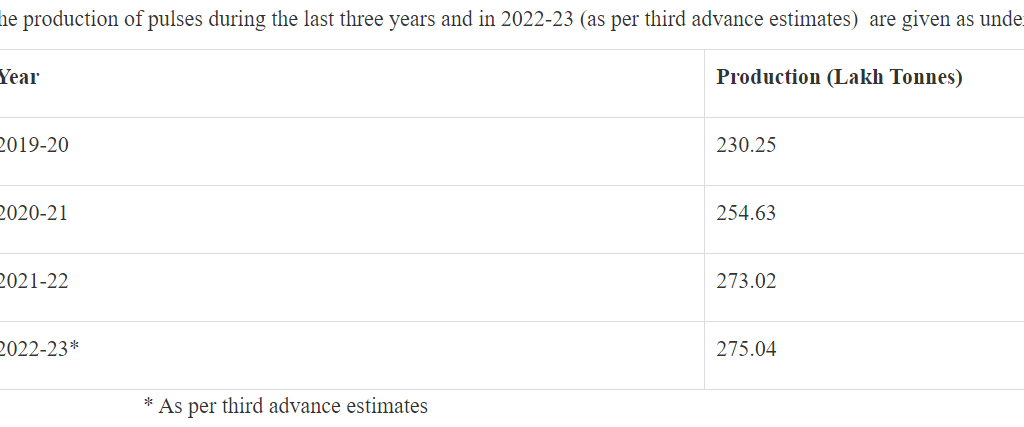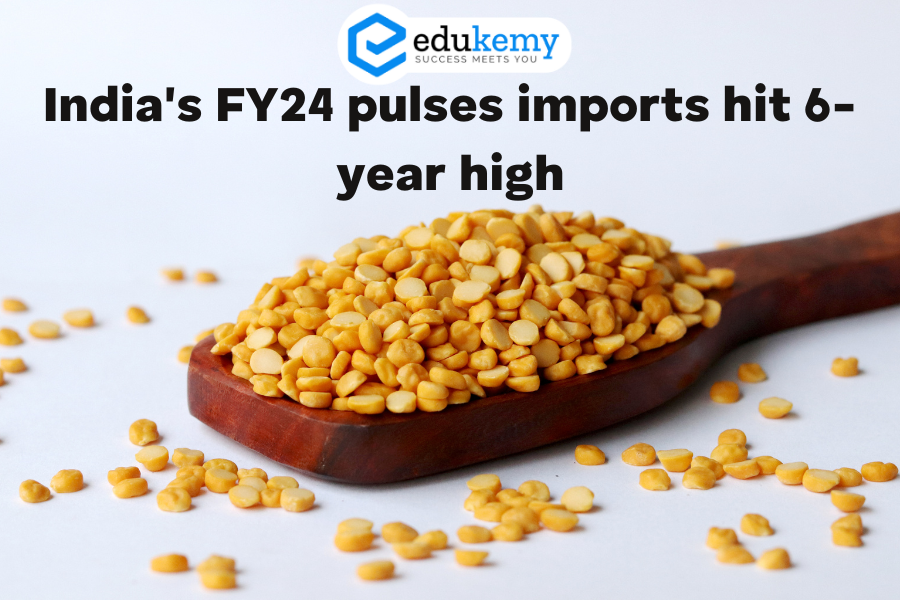
In Fiscal Year 2024, India witnessed a notable surge in its pulses imports, reaching a six-year high. This surge underscores the country’s ongoing reliance on imports to meet its domestic demand for pulses, a crucial staple in Indian cuisine and a primary source of protein for millions. The increase in imports reflects various factors, including fluctuating domestic production levels, changing consumption patterns, and market dynamics both within India and globally. Understanding the dynamics driving this import surge provides valuable insights into India’s agricultural landscape and its broader economic context.
Tags: GS Paper – 3, Buffer Stocks & Food Security– Direct & Indirect Farm Subsidies
For Prelims: Pulse crops, (PM-AASHA), Minimum Support Price (MSP), Indian Council of Agricultural Research (ICAR), hidden hunger
For Mains: Current trends of India’s Pulses production and imports, Issues regarding India’s pulses import, and related government initiatives.
Contents
- 1 Context:
- 2 Pulses environmental conditions:
- 3 UPSC Civil Services Examination, Previous Year Question (PYQ)
- 4 FAQs
- 4.1 Q: What drove India’s pulses imports to a 6-year high in FY24?
- 4.2 Q: Which pulses saw the highest increase in imports during FY24?
- 4.3 Q: How does the increase in pulses imports affect India’s agricultural sector?
- 4.4 Q: What implications does the surge in pulses imports have on India’s economy?
- 4.5 Q: What measures can India undertake to address the challenges posed by rising pulses imports?
- 5 In case you still have your doubts, contact us on 9811333901.
Context:
- The imports of pulses in India surged by 84% during fiscal year 2024, marking a six-year high. This increase is attributed to reduced domestic production coupled with the government’s initiative to exempt import duties on red lentils and yellow peas.

The Current Status of Pulses in India:
- India holds the title of the world’s largest producer, consumer, and importer of pulses, contributing to 25%, 27%, and 14% of global production, consumption, and imports respectively.
- Pulses occupy roughly 20% of the foodgrain area and contribute 7%-10% to the total foodgrain production in India.
- The top five pulses-producing states are Madhya Pradesh, Maharashtra, Rajasthan, Uttar Pradesh, and Karnataka.

India’s Pulses Import Status:
- In the fiscal year 2023-24, India witnessed a significant surge in pulses imports, reaching 4.65 million metric tons, marking the highest since 2018-19.
- In terms of value, the imports soared by 93% to USD 3.75 billion. Notably, red lentil imports, primarily from Canada, doubled to 1.2 million tons.
- The waiver of import duties from December onwards also contributed to increased imports of yellow peas from Russia and Turkey.
- Traditionally, South Asian nations, including India, import pulses from countries such as Canada, Myanmar, Australia, Mozambique, and Tanzania.
Pulses environmental conditions:
- Temperatures ranging between 20-27°C and rainfall averaging 25-60 cm, these crops prefer sandy-loamy soil.
- Moreover, as leguminous crops, except arhar, they aid in soil fertility restoration by fixing nitrogen. Hence, they’re often grown in rotation with other crops.
- Cultivated year-round, Rabi pulses like gram, chana, masoor, and arhar thrive in mild cold climates during sowing, vegetative growth, and pod development.
- Rabi Pulses (contribute over 60%): Gram (chickpea), Chana (Bengal gram), Masoor (lentil), Arhar (pigeon pea).
- Conversely, Kharif pulses like moong, urad, and tur require warm climates from sowing to harvesting.

India’s Initiatives to Boost Pulses Production:
- National Food Security Mission (NFSM)-Pulses:
- The NFSM-Pulses initiative, led by the Department of Agriculture & Farmers Welfare, operates in 28 States and 2 Union Territories including Jammu & Kashmir and Ladakh. Key Interventions Under NFSM-Pulses:
- Assistance to farmers through States/UTs for various interventions.
- Cropping system demonstrations.
- Seed production and distribution of HYVs/hybrids.
- Additionally, the establishment of 150 Seed Hubs for Pulses has significantly contributed to increasing the availability of quality pulse seeds.
- Pradhan Mantri Annadata Aay SanraksHan Abhiyan (PM-AASHA) Scheme:
- This comprehensive umbrella scheme (launched in 2018) comprises three components:
- Price Support Scheme (PSS): Procurement from pre-registered farmers at Minimum Support Price (MSP).
- Price Deficiency Payment Scheme (PDPS): Compensates farmers for price differences.
- Private Procurement Stockist Scheme (PPSS): Encourages private sector participation in procurement.
- ICAR’s Role in Research and Variety Development:
- The Indian Council of Agricultural Research (ICAR) plays a pivotal role in enhancing the productivity potential of pulse crops through research and development efforts. The ICAR focuses on:
- Basic and strategic research on pulses.
- Collaborative applied research with State Agricultural Universities.
- Development of location-specific high-yielding varieties and production packages.
- During the period from 2014 to 2023, an impressive 343 high-yielding varieties and hybrids of pulses have been officially recognized for commercial cultivation across the country.
- The Indian Council of Agricultural Research (ICAR) plays a pivotal role in enhancing the productivity potential of pulse crops through research and development efforts. The ICAR focuses on:
The Reasons Behind India’s Dependence on Pulses Imports:
- Shifting Cropping Patterns: Tradition vs. Trend:
- Historically, Indian farmers practise crop rotation, including pulses. However, recent years have seen a shift towards water-intensive crops like rice and wheat.
- Drivers of Change:
- Demand Dynamics: Rice and wheat are dietary staples, driving increased cultivation.
- Government Support: Incentives such as favourable margins in Minimum Support Prices (MSPs) and assured procurement bolster rice and wheat cultivation.
- Infrastructure: Improved irrigation facilities in certain regions favour rice and wheat.
- Profitability Predicament:
- Economic Considerations: Pulses often yield lower returns per hectare compared to cereals, dissuading farmers from their cultivation, especially on fertile and irrigated land.
- Climate Concerns:
- Vulnerability to Weather: Pulses, primarily rain-fed crops, face challenges from erratic rainfall and droughts, impacting production.
- Technological Lag:
- Research Disparity: Limited advancements in pulse cultivation, coupled with higher susceptibility to diseases and pests, contribute to their lesser adoption compared to cereals and cash crops.
What can be Done to Ensure India’s Self-Sufficiency in Pulses?
- Competitive Minimum Support Prices (MSPs): Ensure that MSPs for pulses are on par with those for crops like rice and wheat to incentivize farmers.
- Subsidies and Support: Provide subsidies for seeds, fertilisers, and other inputs tailored to pulse cultivation. Introduce crop insurance schemes to mitigate risks associated with weather uncertainties.
- Promoting Crop Rotation: Educate farmers on the long-term benefits of crop rotation, emphasising soil health and sustainability.
- Development of High-Yielding Varieties: Invest in research for drought-resistant, high-yielding pulse varieties adaptable to diverse regional conditions. Facilitate farmer training and extension programs to encourage adoption of improved varieties.
- Improving Irrigation Infrastructure: Expand irrigation networks, particularly in drought-prone regions suitable for pulse cultivation. Promote water-efficient techniques such as drip irrigation to conserve water resources.
- Mitigating Price Fluctuations: Enhance storage facilities to minimise post-harvest losses and ensure price stability year-round.
- Streamlining Supply Chains: Improve supply chain efficiency to reduce transportation costs and prevent price manipulation by intermediaries.
- Promotion of Alternative Protein Sources: Encourage dietary diversity by advocating the consumption of protein-rich alternatives like lentils, millets, and eggs to address nutritional deficiencies.
UPSC Civil Services Examination, Previous Year Question (PYQ)
Prelims:
Q:1 With reference to pulse production in India, consider the following statements: (2020)
- Black gram can be cultivated as both kharif and rabi crops.
- Green gram alone accounts for nearly half of pulse production.
- In the last three decades, while the production of kharif pulses has increased, the production of rabi pulses has decreased.
Which of the statements given above is/are correct?
(a) 1 only
(b) 2 and 3 only
(c) 2 only
(d) 1, 2 and 3
Ans: (a)
Mains:
Q:1 How did India benefit from the contributions of Sir M. Visvesvaraya and Dr. M.S. Swaminathan in the fields of water engineering and agricultural science respectively? (2019)
Q:2 Explain various types of revolutions, took place in Agriculture after Independence in India. How have these revolutions helped in poverty alleviation and food security in India? (2017)
FAQs
Q: What drove India’s pulses imports to a 6-year high in FY24?
India’s pulses imports surged in FY24 due to a combination of factors such as lower domestic production, increased demand, and fluctuations in global market prices. The reduced domestic output resulting from adverse weather conditions and pest infestations prompted higher imports to meet the country’s demand.
Q: Which pulses saw the highest increase in imports during FY24?
In FY24, imports of pulses like lentils, chickpeas, and peas experienced notable growth. Lentil imports particularly surged due to a shortfall in domestic production. Chickpea imports also saw an uptick owing to strong demand from consumers and limited availability domestically.
Q: How does the increase in pulses imports affect India’s agricultural sector?
The rise in pulses imports poses both challenges and opportunities for India’s agricultural sector. While it helps meet domestic demand and stabilize prices, heavy reliance on imports underscores the need for enhancing domestic production through improved farming practices, technology adoption, and strategic crop planning.
Q: What implications does the surge in pulses imports have on India’s economy?
The increase in pulses imports can impact India’s economy in several ways. Higher import bills may strain the country’s trade balance, leading to increased expenditure on foreign exchange. Additionally, it highlights the importance of policies aimed at bolstering domestic production to reduce reliance on imports and ensure food security.
Q: What measures can India undertake to address the challenges posed by rising pulses imports?
India can implement a multi-faceted approach to address the challenges associated with rising pulses imports. This may include incentivizing farmers to cultivate pulses through subsidies and support schemes, investing in research and development for crop improvement, promoting sustainable agricultural practices, and fostering strategic partnerships with other pulse-producing nations to ensure a stable supply.
In case you still have your doubts, contact us on 9811333901.
For UPSC Prelims Resources, Click here
For Daily Updates and Study Material:
Join our Telegram Channel – Edukemy for IAS
- 1. Learn through Videos – here
- 2. Be Exam Ready by Practicing Daily MCQs – here
- 3. Daily Newsletter – Get all your Current Affairs Covered – here
- 4. Mains Answer Writing Practice – here

